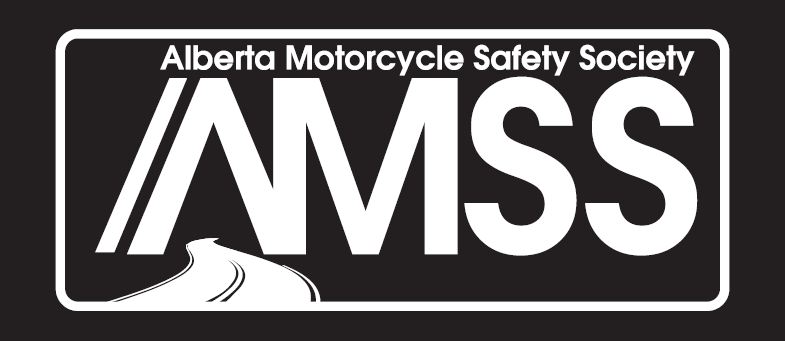Advice for (new) Riders – Part 3
Riding
By: R. Bruce Thomas & Friends**
Just as in real life, where there are always things beyond our control or influence, it is important to understand when riding a motorcycle that you can't control other vehicles, so be in control of your own. Hopefully, all that recommended reading in the previous installment has you in that "being in control" frame of mind, so let's delve into riding tips.
To start with, it's important to understand that motorcycling IS dangerous. Don't pretend otherwise, or you could pay a dear price with injury or death to yourself or others. With that in mind, make sure you are physically and mentally prepared to ride. Never ride if ill, fatigued, or emotionally distracted. i.e. you need to be focused on the task - riding attentively and carefully.
Know your limits and ride your own ride. Don't push beyond your comfort zone to keep up with others. If riding with others, ensure everyone in the group knows where you are going. If faster riders don't want to hang back for the slower ones, arrange some locations along the route to re-group and check on each other. If this doesn't happen, you need different riding companions.
Look as far ahead as possible. Ensure your scanning practice encompasses distant objects both ahead and behind so you have time to be proactive rather than reactive to situations.
Keeping your eyes up, looking well ahead, and maintaining a relaxed grip on the handlebars will help you remain upright.
You go where you look - so look far ahead. Give yourself lots of time to be proactive rather than reactive to situations that may arise. Have a good look at this picture from the Colorado National Monument. It was a quick glance, but I'm hugging the center line to give myself extra room from the drop-off, in case I start going where I'm looking.

Have a good look at this picture from the Colorado National Monument.

Riding on gravel requires a few adjustments to your speed and following distance. Try to avoid the deep stuff. Relax. Look far ahead to choose your line. (Alaska Hwy, Yukon)
Experience riding off-road will acclimatize you to the various rhythms of the machine. Metal-grate bridge surfaces provide a similar sensation to riding on gravel. Many of the top racers, when not on the track, spend ample time on dirt bikes to improve their feel for the machines.
Another reason to be comfortable riding on sand and gravel is if you plan to travel farther afield on your motorcycle. Road construction happens, mainly coinciding with riding season, and you need to navigate through it to get to your destination. Make sure to leave plenty of space between you and the vehicle you are following so you have an unobstructed view of the road surface (this is good advice for all situations but especially true for construction sites).

Always follow the pilot car in construction zones (AK-1 near Glenallen, AK)
In heavier traffic situations use your lane position to ensure you can see past the vehicles in front of you and also to give yourself a quick forward escape route down either side of the vehicle should danger approach from the rear. Staying away from the center of the lane is also good practice since that is where all the oil and crud accumulates after falling off vehicles.
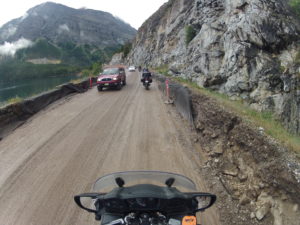
And if there is no pilot car, ride carefully and allow extra space. Don't freak out if it's wet and messy. (Going-to-the-Sun Road, MT)
Pack an umbrella and/or a hat, and an extra sweater. Should you, or a riding companion, breakdown, you will appreciate the protection from the elements that these items will provide.
Practice your cornering and ensure you are mindful of posted speed limits - especially on unfamiliar roads. Cutting a corner short, or running wide, will put you in the weeds or into oncoming traffic and neither option is conducive to getting home safely.
Entering a corner wide (closer to center for right turns and closer to the shoulder for left turns) lets you see further around the curve before committing yourself to the turn and hitting the apex. Always adjust your lane positioning to ensure you have ample spacing from oncoming traffic that may be cutting the corner or running wide themselves.
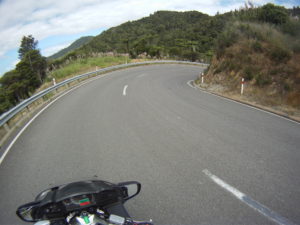
Read the lines to understand the shape of the corner
Read the lines on the road to help understand the shape of the curve. If the lines are getting closer, the corner is getting tighter. If the lines are moving away from you, the corner is expanding or straightening out.
Learn to read the wind. Watch trees, flags, the grass in the medians/ditches, and be prepared for gusts when leaving the relative protection of trees standing beside the road. Watch for blowing dirt/garbage in urban areas. Lean into the wind just as you do in a corner.
Be mindful of wind blasts from big trucks or buses going in the opposite direction. Heck, be ready for a wind blast from the front of a same-direction large vehicle when you pass one. And in both instances, your lane position can affect the impact the blast has on you.
On the topic of large vehicles, don't follow too close, and pass them as quickly as you safely can. A blown truck tire comes off with a lot of force and all that heavy rubber could be quite destructive to a rider.
Keep your brake levers covered while you ride. i.e. keep one, two, three or all four fingers on your front brake lever and the toes on your right foot over the brake pedal. By having the brakes covered like this you will shave about 1/2 a second off applying the brakes should an emergency situation arise. Half a second at city speed is approx seven meters and nearly 14 meters at highway speed. This could make all the difference in safely stopping your motorcycle and avoiding a collision. Now, a quick little test. Earlier I asked you to have a good look at a picture. Did you? Without looking, how many fingers did I have covering my front brake lever? Emergencies can occur anywhere, so ride prepared.
In a previous article I mentioned the credit card sized contact patch between your tires and the road. It is critical that you watch the road surface so you can avoid holes, ruts, lumpy bits, tar snakes, and even puddles. Being a single-track vehicle, a motorcycle is susceptible to getting caught in a rut that can seriously affect your control. Tar snakes are those meandering bits of asphalt put down by road crews to fill in cracks and ruts. They are often not level with the rest of the surface and in hot temperatures they can be quite greasy and slippery.
Also, pay attention when you are coming to a stop to make sure you have a clean surface upon which to plant your foot and it isn't too far down for you to reach it (road camber, tire ruts, etc.)
Speaking of slippery, avoid the painted road lines in the rain.
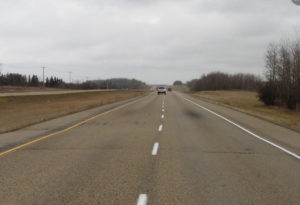
Dip! - Learn to read the road and be prepared
Lumpy bits of road surface can upset your suspension and affect your ability to remain in control. Learn to read the road and be prepared. In the Dip! Picture, the dark spot in the right lane is oil and gunk that has dropped off vehicles because there is a severe dip in the pavement. The left lane shows tire marks from semi's on the far side of the dip. The yellow and white lines also provide a clue.
Puddles indicate a low spot in a road surface and you can't tell how deep they are. Also avoid riding in the tire track depressions where rain accumulates.
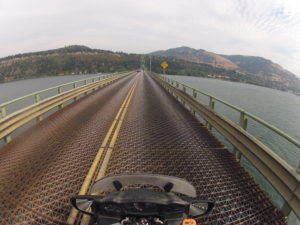
The 1,347m long Hood River Bridge, crossing the Columbia River between Hood River, Oregon and White Salmon, Washington, has a metal-grate surface. Relax!
Be mindful of bridge decks. Wooden decked bridges near waterfalls will be especially slippery from the spray. Even down south, bridges can get frosted in cool weather due to being over water.
Avoid vehicle blind spots. Try to ensure that, when following a vehicle, you can see the driver in their left exterior mirror. When you can see them, then they should be able to see you. Of course, with the tinted windows that many people have, it is hard to actually see a driver or know what they are looking at. Project yourself onto other vehicles. Image you are looking in your direction. Can they see you? If the other driver was taking a photo, would you be in it? What actions do you have to take to make yourself visible?
Once you've done all these things and are confidently in control of your bike, you may wish to start carrying a passenger. There is nothing quite like taking someone special for a ride. Make sure you both understand your responsibilities (see https://ab-amss.org/pillions/) and ensure your passenger wears all the gear, all the time. The same way you do.
Don't drink and ride. Ever. If you're going to continue your ride in the afternoon this means skipping the beer at lunch. Alcohol seems to have a funny way of lubricating your right wrist.
Above all, don't do anything while riding that jeopardizes your safety. If you want to race, go to a track. It's far better to get home late than not at all.
And that covers the advice from my friends and I. Yet, there are so many other riders with other experiences and other innate knowledge. That is why, as part of your lifelong learning as a motorcyclist, you should continually search out and talk to knowledgeable, experienced riders to learn more about riding. And when you have knowledge and experience make sure you share it with others.
*After responding to a tweet (“What advice would you give a new rider?”) from the Texas Motorcycle Safety and Awareness Campaign (@LookLearnLive) last August, I sent the question to my riding friends to get a greater perspective. Their responses have helped form this 3-Part series.
For reference sake, I’ve got friends who have:
- raced on the track,
- ridden on the Bonneville Salt Flats,
- completed the Iron Butt Rally (some more than once!),
- ridden 100’s of thousands of kilometers,
- survived serious crashes
- done gnarly things in the dirt,
- removed a wheel and repaired a flat tire on the side of the road,
- many other useful skills.
